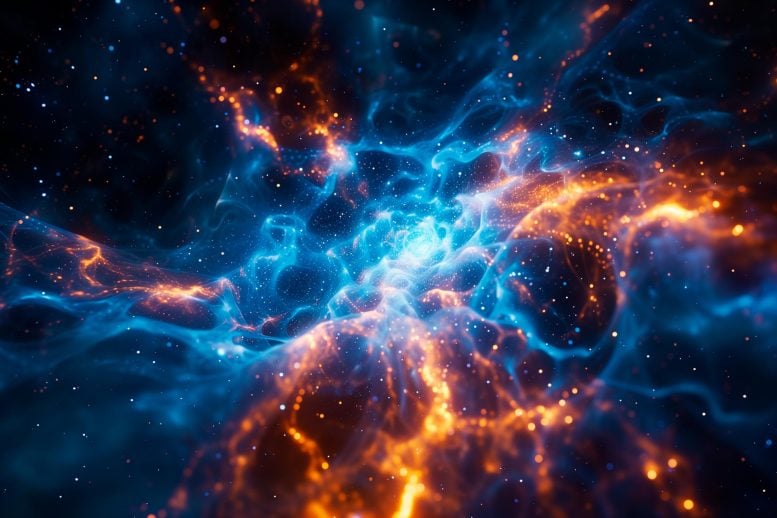
Simulations of the galaxy cluster “El Gordo” suggest that dark matter may be self-interacting, supporting the Self-Interacting Dark Matter (SIDM) model over the standard collisionless dark matter model. Credit: SciTechDaily.com
A new study indicates that dark matter in the “El Gordo” galaxy cluster exhibits collisional properties, challenging the standard model of collisionless dark matter.
Contrary to what is established by the standard model, dark matter may indeed be self-interacting. This was the conclusion of a new piece of research conducted by Riccardo Valdarnini of SISSA’s Astrophysics and Cosmology group and published in Astronomy & Astrophysics (A&A).
Using numerical simulations, the study analyzed what happens inside “El Gordo” (literally “The Fat One” in Spanish), a giant cluster merger seven billion light years away from us. The calculations indicated that in this cluster the observed physical separation between the points of maximum density of dark matter and those of the other mass components can be explained using the so-called SIDM (Self-Interacting Dark Matter) model, as opposed to the standard one.
This research makes an important contribution in favor of the SIDM model, according to which dark matter particles exchange energy through collisions, with interesting astrophysical repercussions.
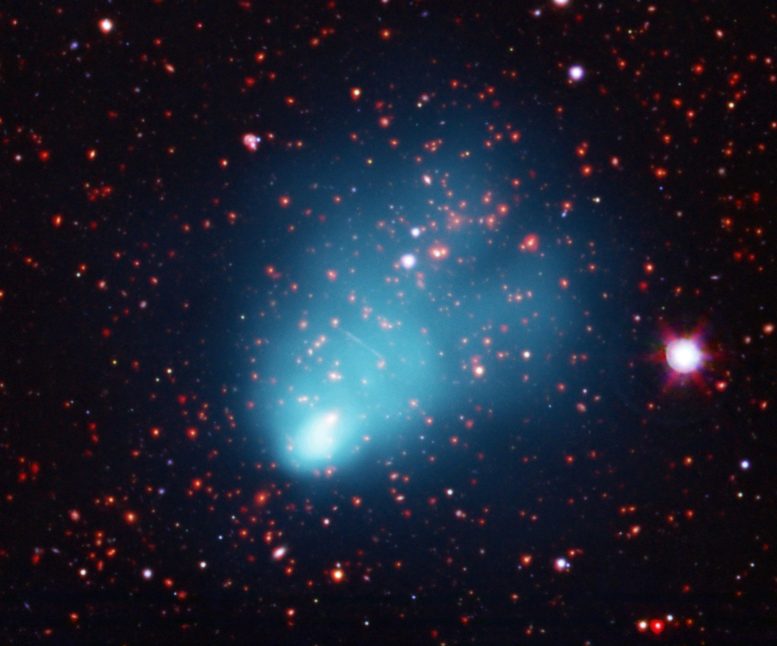
El Gordo Galaxy Cluster composite. Credit: X-ray: NASA/CXC/Rutgers/J.Hughes et al, Optical: ESO/VLT/Pontificia Universidad. Catolica de Chile/L.Infante & SOAR (MSU/NOAO/UNC/CNPq-Brazil)/Rutgers/F.Menanteau, IR: NASA/JPL/Rutgers/F.Menanteau
“El Gordo”: A Gigantic Cosmic Structure for the Study of Dark Matter
“According to the currently accepted standard cosmological model, the present baryonic matter density of the Universe can account for only 10% of its total matter content. The remaining 90% is in the form of Dark Matter,” explains Riccardo Valdarnini, author of the research.
“It is generally thought that this matter is nonbaryonic and made of cold collisionless particles, which respond only to gravity. Hence the name “Cold Dark Matter” (CDM). However, there are still a number of observations that have not yet been explained using the standard model,” says the researcher. “To answer these questions, several authors suggest an alternative model, called SIDM.”
Proving the collisional properties of dark matter and, more generally, alternative theories to the standard cosmological model one is very complicated: “There are, however, unique laboratories that can prove very useful for this purpose, many light years away from us. These are the massive galaxy clusters, gigantic cosmic structures that, upon collision, determine the most energetic events since the Big Bang. With a mass of about 1015 solar masses, El Gordo is one of the largest galaxy clusters we know. Due to its peculiarities, El Gordo has been the subject of numerous studies, both theoretical and observational.”
Dark Matter Could be Collisional
According to the standard paradigm, during a cluster merger the behavior of the collisional gas mass component will differ from that of the other two components — galaxies and dark matter. In this scenario, the gas will dissipate part of its initial energy.
“This is why, after the collision, the peak of gas mass density will lag behind those of dark matter and galaxies,” explains Valdarnini.
With the SIDM model, however, a peculiar phenomenon should be observed, namely the physical separation of dark matter centroids — its maximum density points — from those of other mass components with peculiarities that represent a true “Signature of SIDM models.” According to observations, this is exactly what happens inside “El Gordo.”
Observing El Gordo
“Let us start with observations:” explains Valdarnini. El Gordo consists of two massive subclusters, respectively denominated northwestern (NW) and southeastern (SE). The X-ray image of the “El Gordo” cluster shows a single X-ray emission peak in the SE subcluster and two faint tails elongated beyond the X-ray peak. A noteworthy feature is the peak location of the different mass components. At variance with what can be seen in the Bullet Cluster, another important example of a colliding cluster, the X-ray peak precedes the SE dark matter peak.
“Moreover, the Brightest Cluster Galaxy (BCG) is not only trailing the X-ray peak, but it also appears to be spatially offset from the SE mass centroid. Another notable aspect can be seen in the NW cluster, where the galaxy number density peak is spatially offset from the corresponding mass peak.”
The Role of Collisional Dark Matter in “El Gordo” Phenomena
In order to explain his findings and validate the SIDM models, in the study published in Astronomy & Astrophysics, Valdarnini used a large set of so-called N-body/hydrodynamical simulations. Thus, he carried out a systematic study aimed at reproducing the observational features of “El Gordo.”
“The most significant result of this simulation study is that the relative separations observed between the different mass centroids of the “El Gordo” cluster are naturally explained if the dark matter is self-interacting,” states Valdarnini. “For this reason, these findings provide an unambiguous signature of a dark matter behavior that exhibits collisional properties in a very energetic high-redshift cluster collision.
“There are, however, inconsistencies, as the SIDM cross-section values obtained from these simulations are higher than present upper limits, which are of order unity at cluster scales. This suggests that present SIDM models should be considered as only a low order approximation, and that the underlying physical processes that describe the interaction of dark matter in major cluster mergers are more complex than can be adequately represented by the commonly assumed approach based on the scattering of dark matter particles.
“The study makes a compelling case for the possibility of self-interacting dark matter between colliding clusters as an alternative to the standard collisionless dark matter paradigm.”
Reference: “An N-body/hydrodynamical simulation study of the merging cluster El Gordo: A compelling case for self-interacting dark matter?” by R. Valdarnini, 12 April 2024, Astronomy & Astrophysics.
DOI: 10.1051/0004-6361/202348000

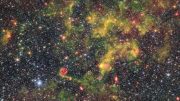


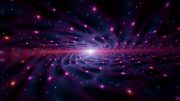

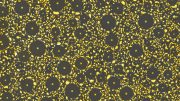


“El gordo” is better translated as fat man, or boy. La gorda would be the fat woman, or girl.
No reason I can see to not downgrade the DM effect to a rippled gravitational “aura artifact,” one capable of resembling an off-focus image of underestimated bright masses, but with the possibility of mutual phase-cancellation in the rippling between widely separated sources. The upshot is scientists need to stop pretending “dark matter” isn’t a demented “placeholder” for constructing misleading sentences. It’s not a fair placeholder until the word “effect” is added, but of course all the expert egos are politically married to it now.
The DM effect I’m describing here would be a radiated gravity effect, meaning the ripple locations will lag their sources to some extent, dependent on source motion. Ripples are capable of interfering just as opposing gradients can cancel, in other words crossing ripples in a gravity field can mutually cancel at some points without the ripples having to be carrying a true gravitational sign-change.
Compressing the point here further, there should be some way of greatly focusing down the amount of information actually carried in the DM effect shown here by using motion-dependent image basis functions carrying rippled gradient profiles after correctly guessing how much mass is being underestimated in the various brightest sources.
As far as which bright spots to blame the most, it’s difficult for me to avoid thinking of “Ricky Rat” in any analysis here. The bright nose and the dimmer ears stand out. It seems sources for these three loci are largely drifting in the same direction – downward to the right.
“right”
The “nose” source seems at the moment to swerve right after moving leftward and down, anyway. My main point should be that it seems three drifting bright masses could source most of the effect.
Noticed another attempt to map out the DM on this same cluster this morning and it seems quite a bit more angular, which highlights another point I wanted to make here, which is that the process of creating a DM mapping typically involves making some potentially arbitrary choices on dark gravity source positions.
Gravity of the galaxý is always attractive or positive for the normal visible matter;so,this has an orientation,which guides the dark matter/dark energy for implementation of collision method through determination of line of collision to have a vector for combination of both type of matter.